“Stephen, what an amazing story. The manner in which you have woven facts and artifacts together is extraordinary. Your work will, no doubt, inspire others to embark upon their own personal journey to chronicle their family history. I enjoyed every word. I also appreciate the reference and inclusion on my book and image. Thank you for a wonderful piece of history. Great job!!”
Craig James
“What a fascinating piece. I particularly enjoyed reading about how your detective work uncovered the larger story. And the family pictures are priceless. You’ve inspired me to do more research on the Civil War soldiers from our house. Thanks so much for sharing it.”
Mary Ann Zeman
My family has been pretty damn good about taking and saving family photographs. It’s quite cool in itself to see a family portrait which covers three generations.
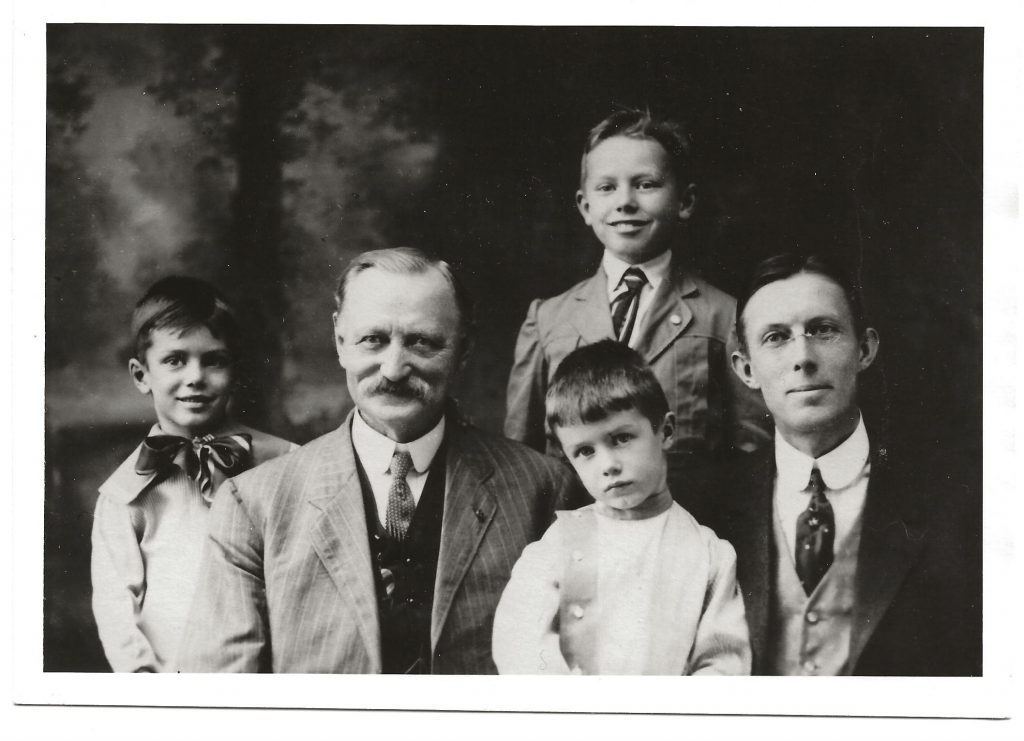
Fig. 1. Three generations of Grants, 1912
I don’t know who took the picture nor where, but I identify:
My great-grandfather, Maj. Hiram Lewis Grant, second from left; and
his eldest of three children, my grandfather, Rev. John Hiram Grant, at right.
John Hiram’s children were all boys; my father, Stephen Walkley Grant, in front;
my uncle, John Phillips Grant, at left; and my uncle Alfred Hall Grant, in back.
At 69 years old, Hiram with his broad shoulders dwarfs his progeny. Only my father, age 4, is tieless. He has the most pronounced dimple. While his older bros are smiling, Dad, like his father and grandfather is closed-lipped. I am very proud of how my grandmother, Margaret Knowlton Hall Grant, dressed her boys to a tea for the studio portrait of three generations. It must have been an event at the time, but who knows whether they ever talked about it afterward?
To follow the line, we have:
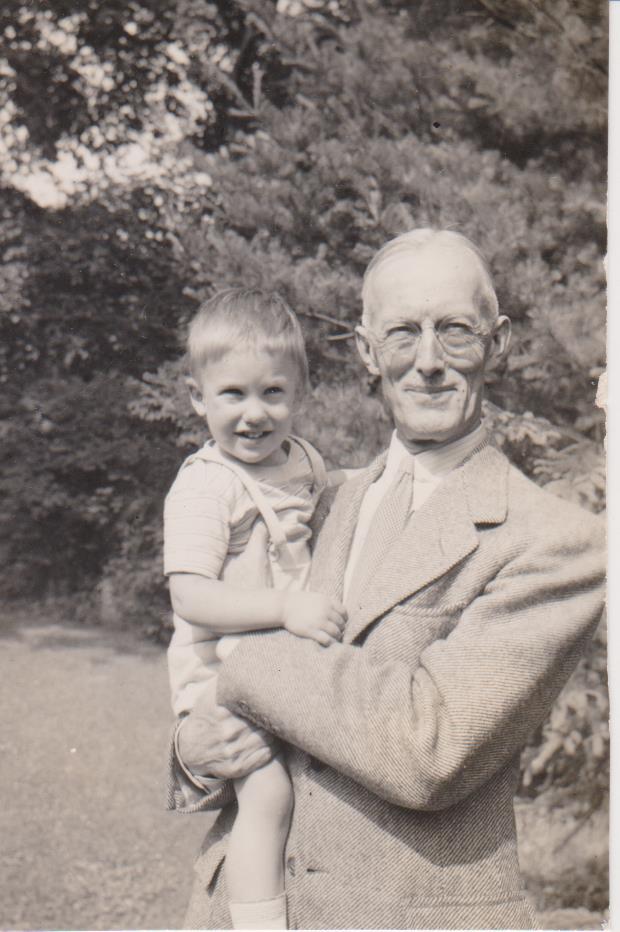
Fig. 2. My Grandfather and me, 1944
Wellesley, MA
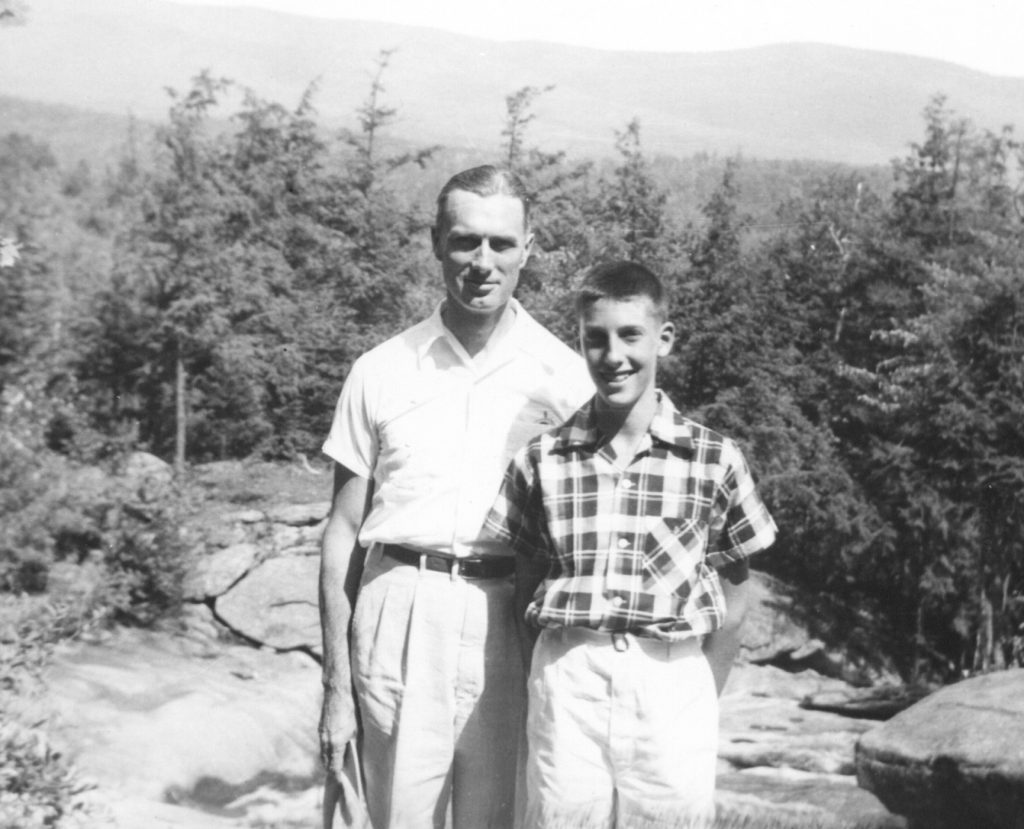
Fig. 3. My Father and me, 1953
Goves Falls, NH
If one were to add a fourth generation, one would get, in the male line:
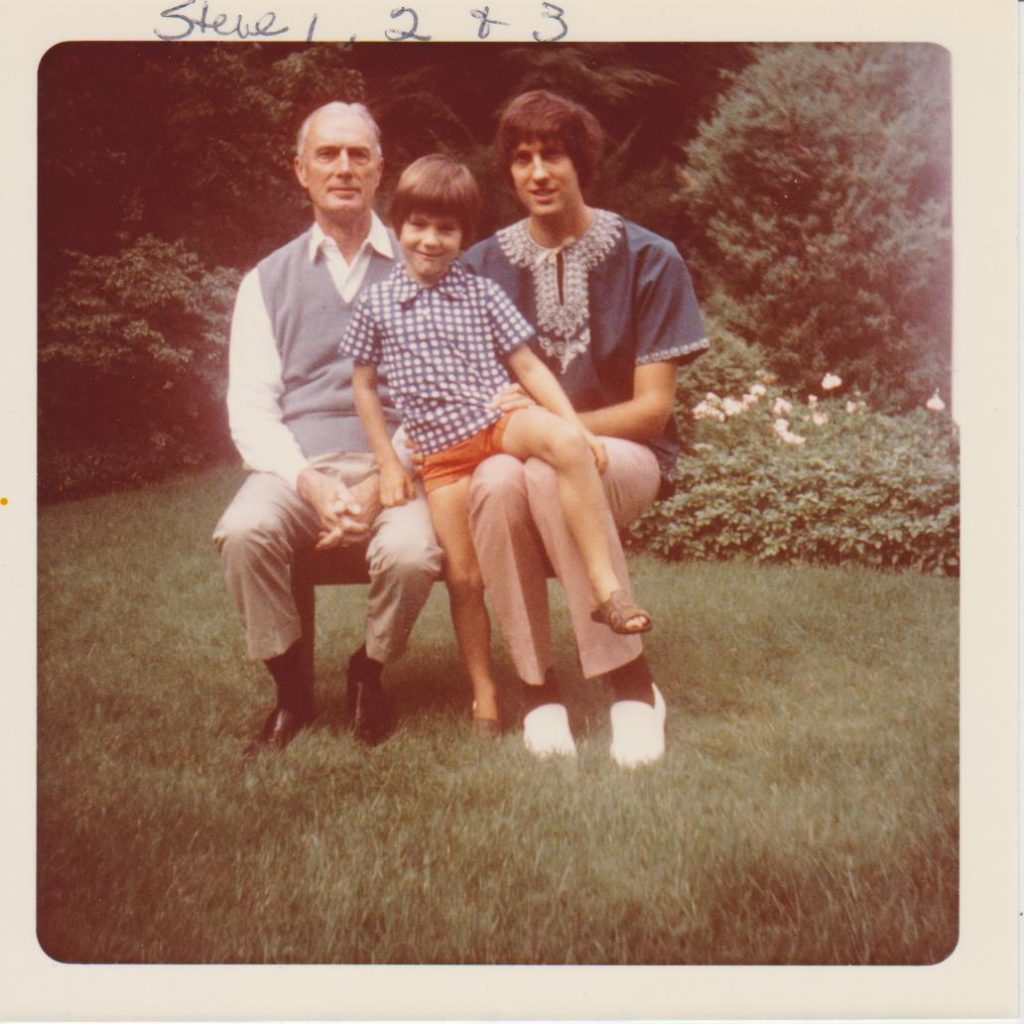
Fig. 4. My Father, My Son Yonel, and me, 1972
Wellesley, MA
Black and white photos have given way to color, formal to informal dress, and studio to backyard setting. I need an aside to explain the caption in my Mother’s hand above the three-generational image in Fig. 4: “Steve 1, 2, & 3.” Stephen Walkley Grant is Steve 1; Stephen Hall Grant is Steve 2. The story gets more complicated with Steve 3. My French wife Annick and I decided to name our son Yonel Lekadou Grant. Lekadou is a name in the Bété language of Ivory Coast that means “treasure of the village.” When Yonel was born in France, I was in Ivory Coast, having recently completed my Peace Corps assignment. My father-in-law went to register the newborn’s name at the town hall in Qt. St. Jacques, Grasse. On the spot, he added Steve to make it Yonel Steve Lekadou Grant’s official name. Pls note in Fig. 4. my good hair day.
I was going about my life for three-quarters of a century until one day––perhaps sparked by my sister Corie’s self-published memoir in 2011, Our Family Heritage: The Hart, Hincks, Welles, Waller, Hawley, and Grant Families by Cornelia Ann Grant Nichols––I decided to look into my great-grandfather’s life. It was Mar. 8, 2020, and I was looking forward to attending the annual “DC ANTIQUE PHOTO, POSTCARD & CIVIL WAR SHOW at the Rosslyn Holiday Inn in Arlington, VA.
There was just one hitch. Covid 19 had just been declared, and we were warned to wash our hands for 20 seconds, not to get close to people, not to rub our eyes. I decided I would throw caution to the winds, however, thinking, “Hell, if I die, at least I will have had some fun sleuthing among dusty old postcards, sober daguerreotypes in fancy frames, and I didn’t know what to expect in the Civil War room, as I had never crossed that threshold before.
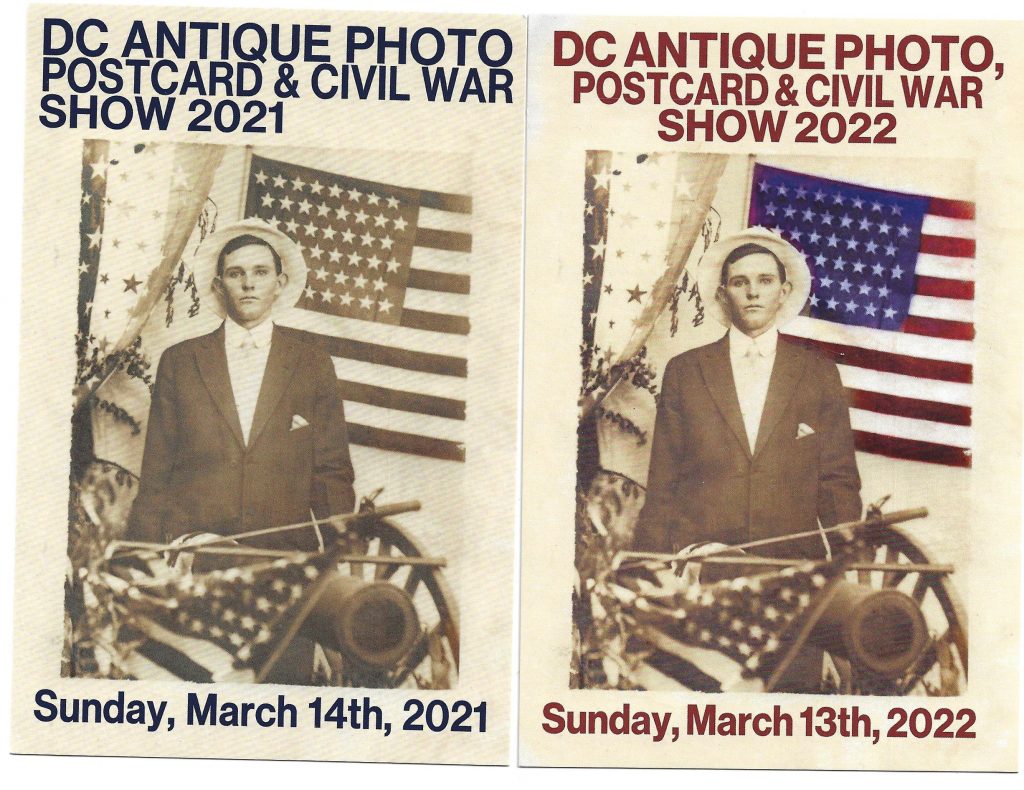
Fig. 5. Postcards Announcing Civil War Shows in DC, 2021, 2022
I exchanged business cards with the following gentlemen I met during the one hour I spent in the Civil War room in 2020: Kurt Luther, Columnist, Photo Sleuth, MilitaryImagesMagazine.com; Ron Coddington, MilitaryImagesMagazine.com; Paul J. Brzozowski, dealer in historic American documents and Letters. It was an unfamiliar world for me, but not totally new for since the 1980s I had attended old postcard shows and was accustomed to the back-and-forth between buyers and sellers of ephemera.
Behind a table and propped behind a computer screen, Kurt Luther was wearing a VIRGINIA TECH sweatshirt and looked to me like a graduate student. Actually he’s an Associate Professor of Computer Science and Director of the Crowd Intelligence Lab. “The Civil War counted three million combatants on both sides,” he informed me. “Our data base includes photographs of thirty thousand. What did you say your great-grandfather’s name was again?” Let’s see whether we’ll have any luck.
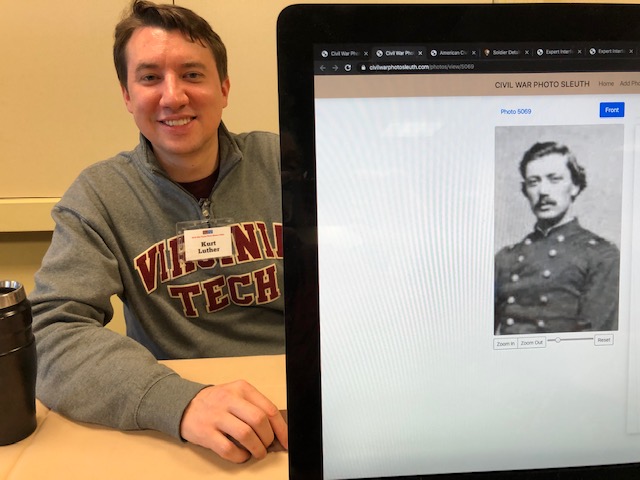
Fig. 6. Kurt Luther on left, Hiram Grant on right
Photo by Stephen Grant, March 8, 2020
Look how Kurt is smiling in this photo. You should have seen how I was beaming! Would you believe it? Double Bingo! The Virginia Tech data base included two photos of my relative, in a major’s dress uniform.
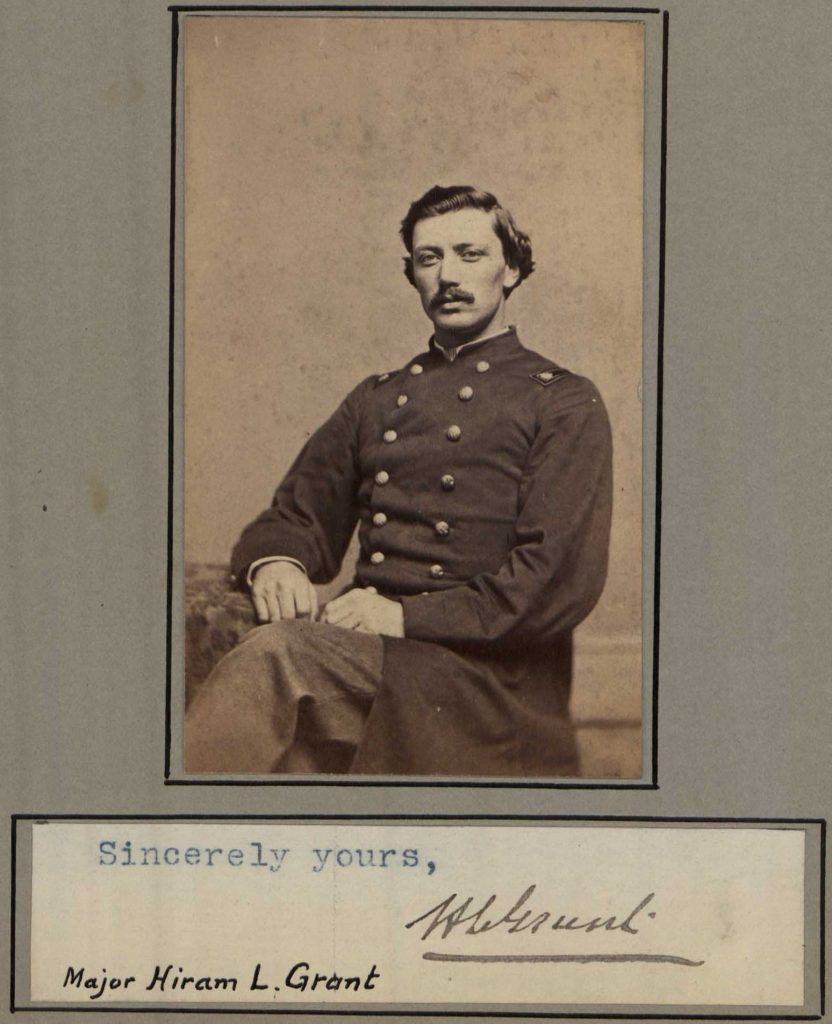
Fig. 7. Major Hiram L. Grant, sitting
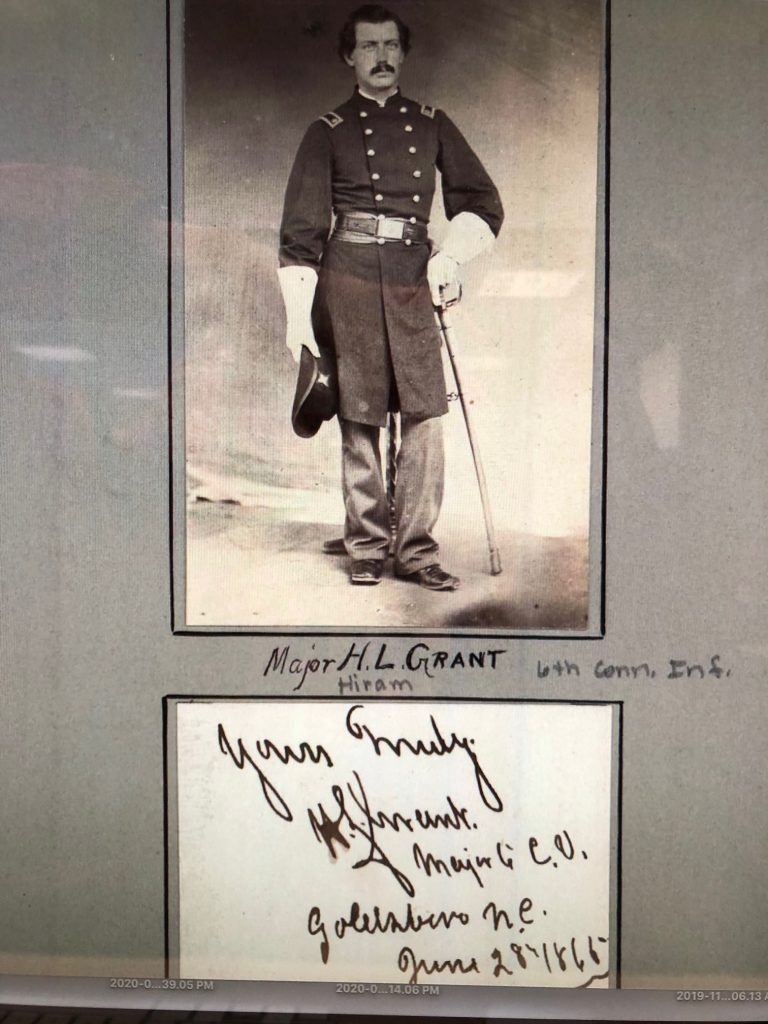
Fig. 8. Major Hiram L. Grant, standing
Under one photo is typed “Sincerely yours,” and the other handwritten “Yours truly.” Most helpful is the added precision of the date, June 28, 1865 and the location, Goldsboro, NC.
Kurt told me the originals of the two images––in a scrapbook, it looks like––are housed in the U.S. Army Military History Institute (MHI) in Carlisle, PA.
I thought that might have been it. After hitting the jackpot, then what do I do? I hesitated as to my next move. Kurt generously filled in the void from his deep knowledge of Civil War uniforms. “There doesn’t seem to be any other visitor anxious to consult our data base right now, so let me tell you something about the shoulder straps,” Kurt launched in. I hadn’t even noticed the pair of straps on the shoulders of Hiram’s uniform in both portraits.
“In the later years of the war, officers began to recognize that their distinctive shoulder straps with gold borders made them a target for sharpshooters. So they began to adopt ‘subdued’ insignia which omitted the gold borders and was less noticeable from a distance. It is possible, but not definite, that the standing view of Hiram Grant predates the seated view because he has the gold-bordered straps in the former and subdued rank in the latter. That may suggest the seated view is later in the war.” Wow, I thought. That’s absolutely amazing!
“Grant was promoted to major in Jan. 1864 and lieutenant colonel in Nov. 1864. So both photos are fairly late in the war. Unfortunately, the insignia for both ranks appears the same: oak leaves on the straps. The major would be gold and the lieutenant colonel silver, but that difference can’t be discerned from period photos, to the frustration of us modern researchers. So it’s impossible to say which rank he held in the two photos except that he was definitely one of the two. One could speculate that when he was promoted to lieutenant colonel, he took the opportunity to purchase subdued insignia, which supports the theory that the seated view is later. I believe that adopting ‘subdued’ insignia was never official army policy, but officers bought their own uniforms anyway, so it was something that developed informally. By the way, this tradition of “subdued” rank insignia has carried forward to the modern-day Army. When soldiers are in garrison, they wear the colored (red / white / blue) US flag patch on their shoulder sleeve. When they are deployed in the field, they wear a subdued (olive / black) flag.” I left the Civil War room at the annual DC show energized to look further into my great-grandfather’s story.
I had not gone to the Civil War room on Mar. 8, 2020 emptyhanded. I had brought the reproduction of a photo of Hiram Grant taken in 1919 and included in a 1986 article by John Bell, Jr. that appeared in the Dictionary of North Carolina Biography, 6 volumes, edited by William S. Powell (UNC Press, 1979–1996. Given its relevance to the blog post at hand, I copy the first paragraph of said article:
“Grant enlisted as a private in Company A, Sixth Connecticut Volunteer Infantry on 3 Sept. 1861 and gradually rose in rank to major. On 23 July 1863, he was one of twenty volunteers sent to silence the guns of Fort Wagner on Morris Island at Charleston harbor. Seriously wounded in the action, he was awarded the medal of honor by General Q. A. Gillmore on 23 Aug. 1863. After being confined for eight months to a hospital in Beaufort, N.C., Grant was reassigned to the staff of General Joseph R. Hawley (/biography/hawley-joseph-roswell) of the Tenth Army Corps and served in that position during the entire Virginia campaign. Grant commanded a portion of the Union troops that made the successful assault on Fort Fisher in January 1865. Subsequently he was appointed provost marshal of Wilmington and later of Goldsboro. The white population of these two towns greatly disliked the black troops he commanded. Grant was honorably discharged from the army on 24 Aug. 1865. During the Spanish-American War he returned to active duty for thirteen months as paymaster in the District of Columbia, Puerto Rico, and New York City.”
It is from the John Bell Jr. article that I learned for the first time that Hiram Grant commanded black troops. I’d like to know more about my ancestor’s commanding Colored Troops, including the part about the white population “greatly disliked the black troops he commanded.” In Figs. 16. & 17, we will see Hiram’s mention of Colored Troops.
I was not to leave Kurt Luther’s computer station, however, without becoming the subject of a short video! Anne Coddington, who leads Social Media for Military Images magazine, was walking around the Civil War room on the lookout for a story. She overheard Kurt and me talking about my relative and of the uncanny luck in the Virginia Tech’s data base holding not one but two photos of Major Grant.
https://www.facebook.com/militaryimages/videos/566446857292885
Author Stephen Grant speaks of his great-grandfather, Union Major in the Civil War and
Professor Kurt Luther about his website, www.civilwarphotosleuth.com
My family saved significant documents from Hiram Grant’s Civil War service:
One: 7/17/1863 letter to his parents in Putnam CT from Hiram Lewis Grant on Morris Island, SC. Dimensions: 9 3/4 x 19 7/8.
Two: Stamped envelope with 3-cent brown Washington 1861 Scott A25. Dimensions: 3 x 5 1/2.
Three: United States Sanitary Commission, Washington, D.C. Battle and Hospital Directory
ReturnAction at Morris Island July 18, 1863
Patient Hiram L. Grant, Sergt Co. A 6th C. V. Hosp no. 5, Beaufort, S.C.
Wound report 7/18/1863 Co A, Regt 6th Conn. Residence Putnam Conn.
Right flesh wound mid-thigh, conical ball, severely, ball extracted, doing well
C.M. Christy in charge of hospitalization.
Hospital #5 Beaufort, S.C. Sanitary Commission, Beaufort, S.C. Dimensions: 4 7/8 x 7 5/8
Four: Hiram Lewis Grant’s Diagram: The Execution of Prisoners. Dimensions: 6 x 7 5/8.
After consultation with my family, on Oct. 19, 2021, I made a donation of the above-cited four documents to the Wayne County Public Library in Goldsboro, NC in memory of Marty Tschetter (1970–2021), Local History Librarian. I first called Marty on May 2, 2019 to ask about my great-grandfather. He surprised and pleased me by saying he had been collecting information on Hiram Grant because of the prominent role he played as a Goldsboro business leader and philanthropist. He sent me many photos (especially on the brick houses Grant lived in or built about town) and articles which I shared with other Grants. On May 1, 2020, just a year later, Marty sent me his last email, announcing he had been diagnosed with advanced cancer. He had been planning a trip to Washington, DC with a friend to visit the National Archives and we had been looking forward to meeting.
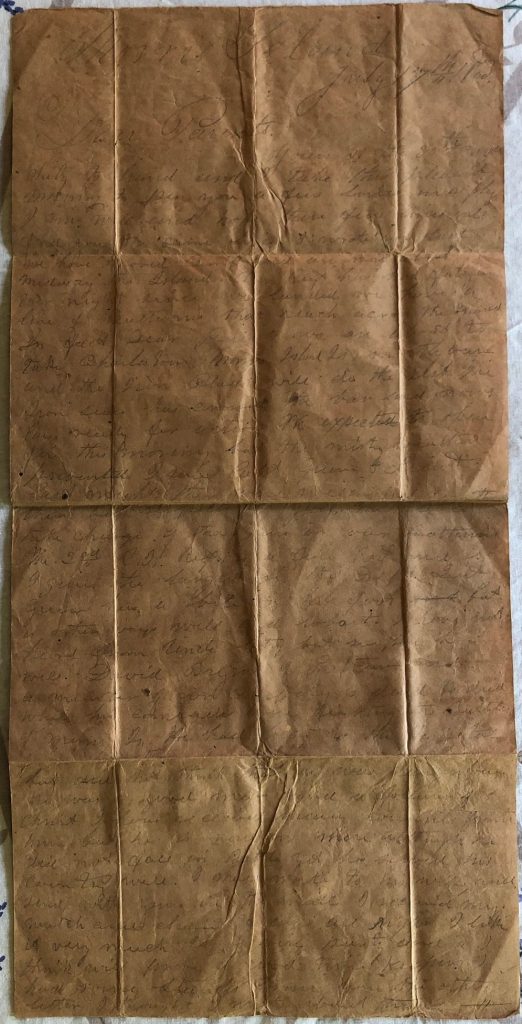
Fig. 9. Hiram L. Grant letter from Morris Is., SC to his parents in Putnam CT, July 17, 1863
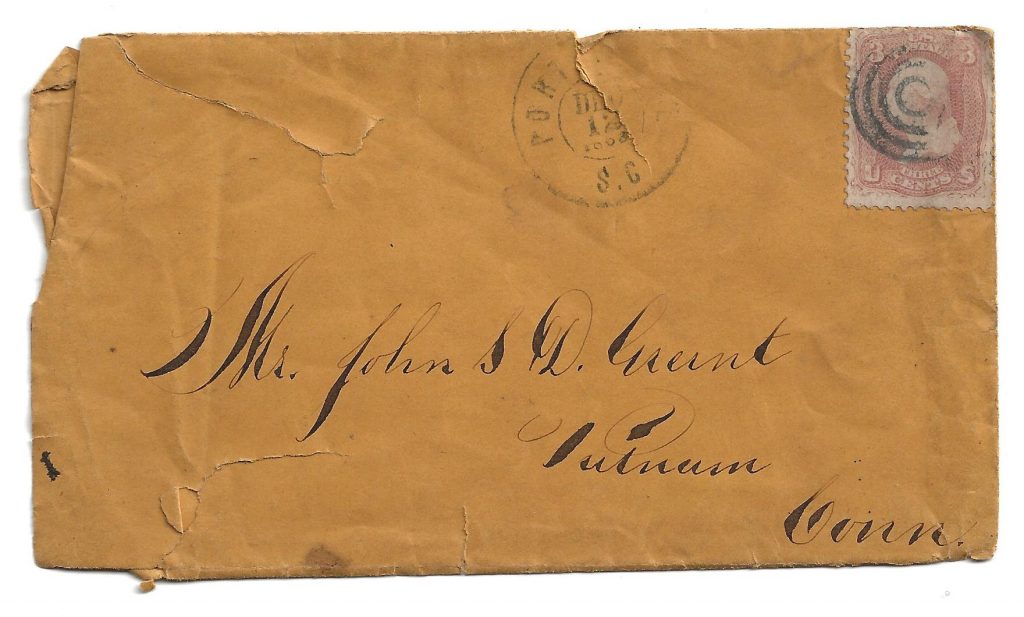
Fig. 10. Grant envelope (front) from Morris Is., SC to his parents in Putnam CT, July 17, 1863
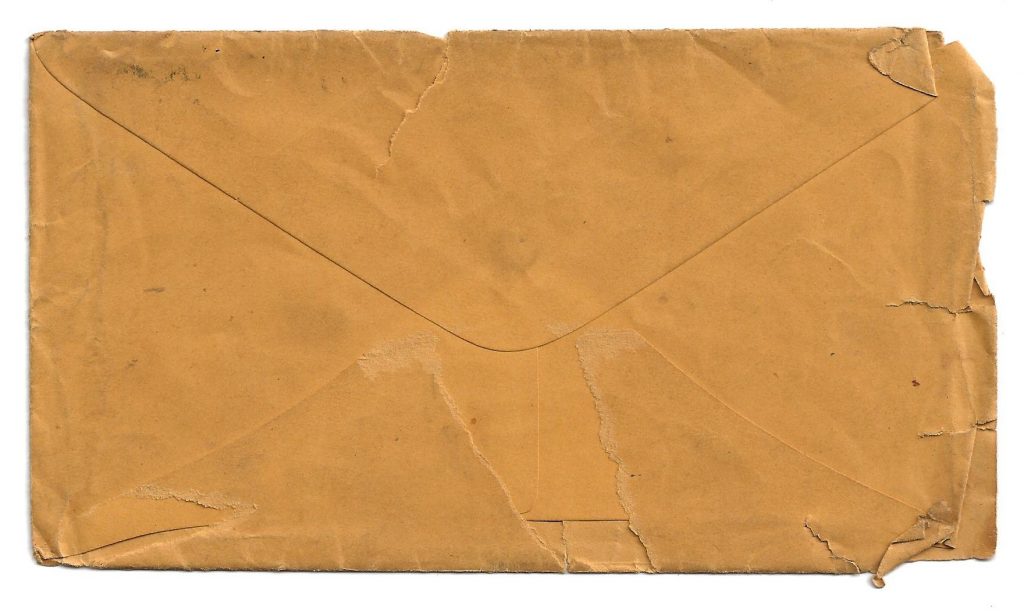
Fig. 11. Grant envelope (back) from Morris Is., SC to his parents in Putnam CT, July 17, 1863
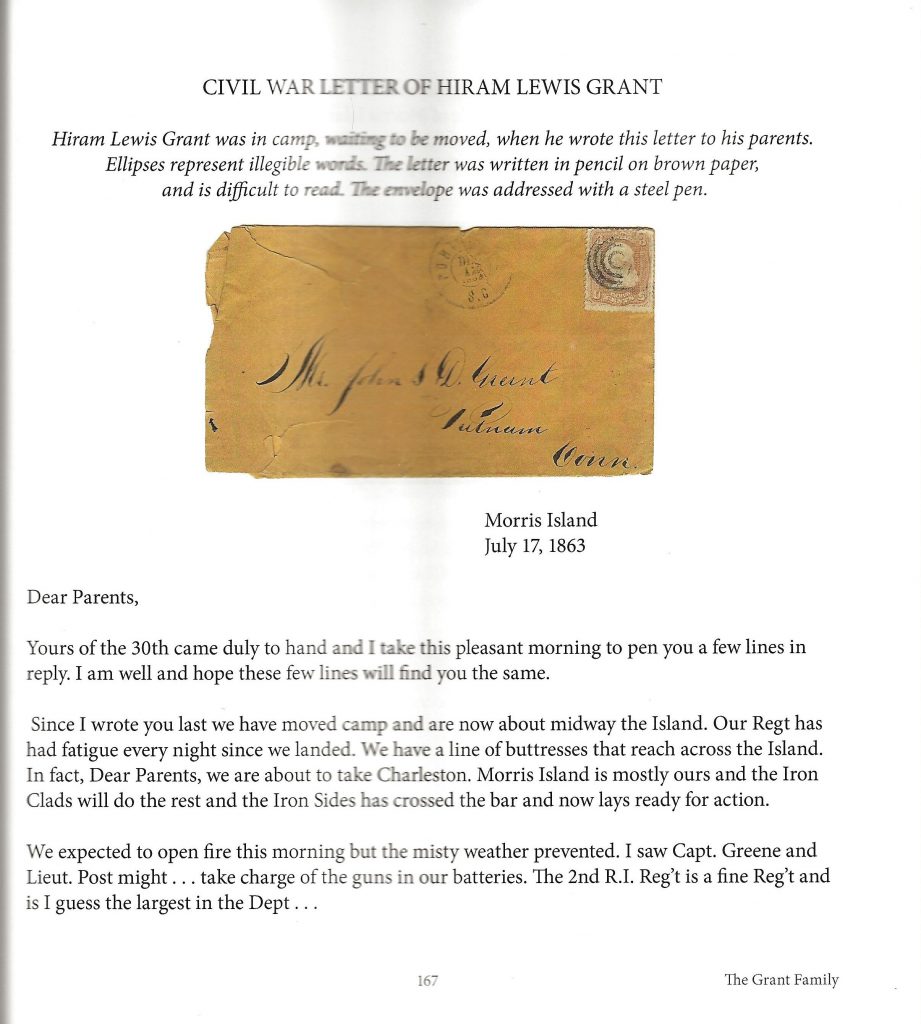
Fig. 12. Our Family Heritage, the Grant Family. Page 167
Envelope sent to Mrs. John S. D. Grant, Putney, Conn.
Hiram Grant letter to his parents from Morris Is., SC July 17, 1863, part 1
I expected to find on this envelope a postmark with a date a few days after the letter was written, July 17, 1863. The postmark was Dec. 12, 1863, just short of five months. The provenance was Port Royal, S.C., 83 miles to the west of Morris Island. I hope a specialist in postal history could suggest likely reasons for the long delay.
Hiram notably writes in the penultimate paragraph, “we have to resort to secesh paper.” Wouldn’t the second and third paragraphs contain information that could qualify as military secrets?
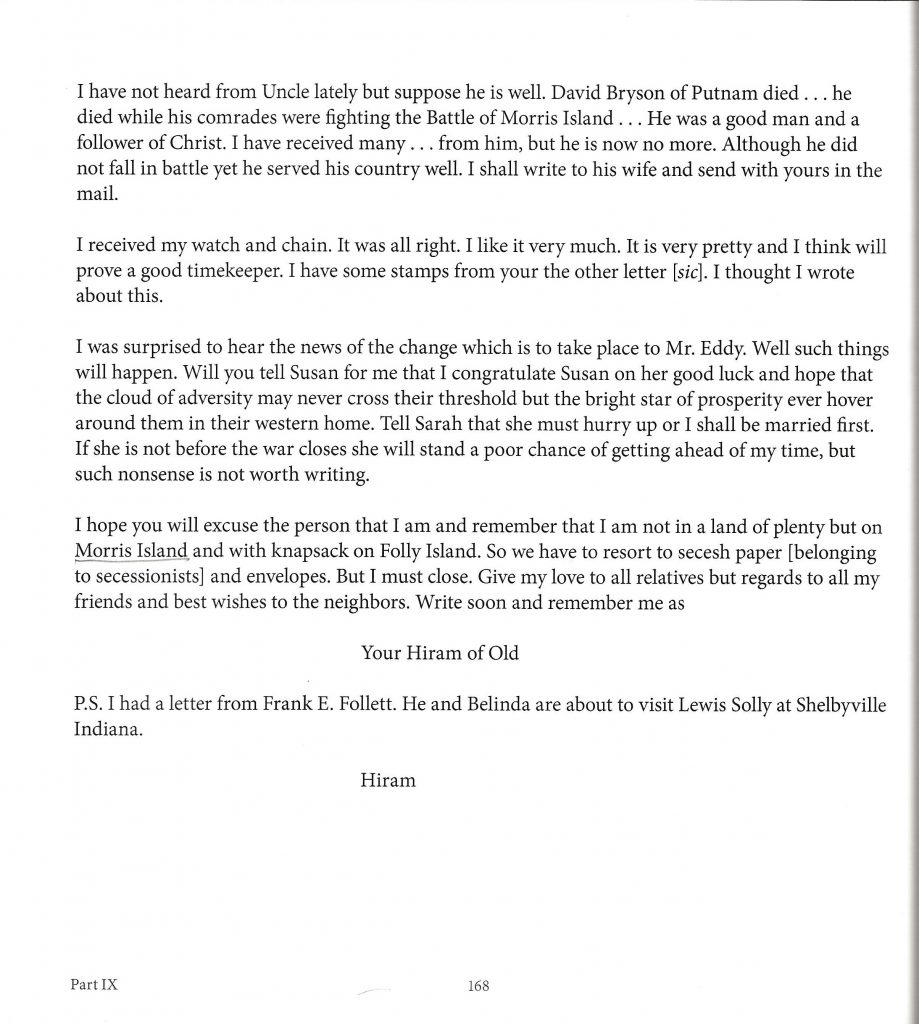
Fig. 13. Our Family Heritage, the Grant Family. Page 168
Hiram Grant letter to his parents from Morris Is., SC July 17, 1863, part 2
The fourth paragraph announces that a fellow soldier from Putnam has died. The fifth paragraph reveals that Hiram’s parents were able to send not only letters but packages; in this instance, a watch and chain. I assume that books have been written about the postal service during wartime. The paragraph ends with reference to “some stamps.” I know for a fact that my grandfather John Grant was a stamp collector, because in about 1950 his stamp collection was passed on to my father. Hiram’s father, who died on Aug. 8, 1890, would have been alive when the first U.S. postage stamp was issued in 1840. The sixth paragraph, the longest, evokes, with some banter, marital news from Putnam, friends tying the knot. We learn that Hiram had not yet married. The last paragraph makes it clear that while Hiram is writing from Morris Island, his knapsack is on Folly Island, a seven-square-mile barrier island in the Atlantic Ocean used as a staging area for Union troops before the battles of Fort Wagner. One request in this final paragraph appears quite poignant, although obscure: “I hope you will excuse the person that I am.” I don’t consider the closing of “Your Hiram of Old” a usual saying uttered by a youth of 20. Perhaps it is to reassure the faraway parents that their son is still the same despite fighting in a war to keep the nation together.
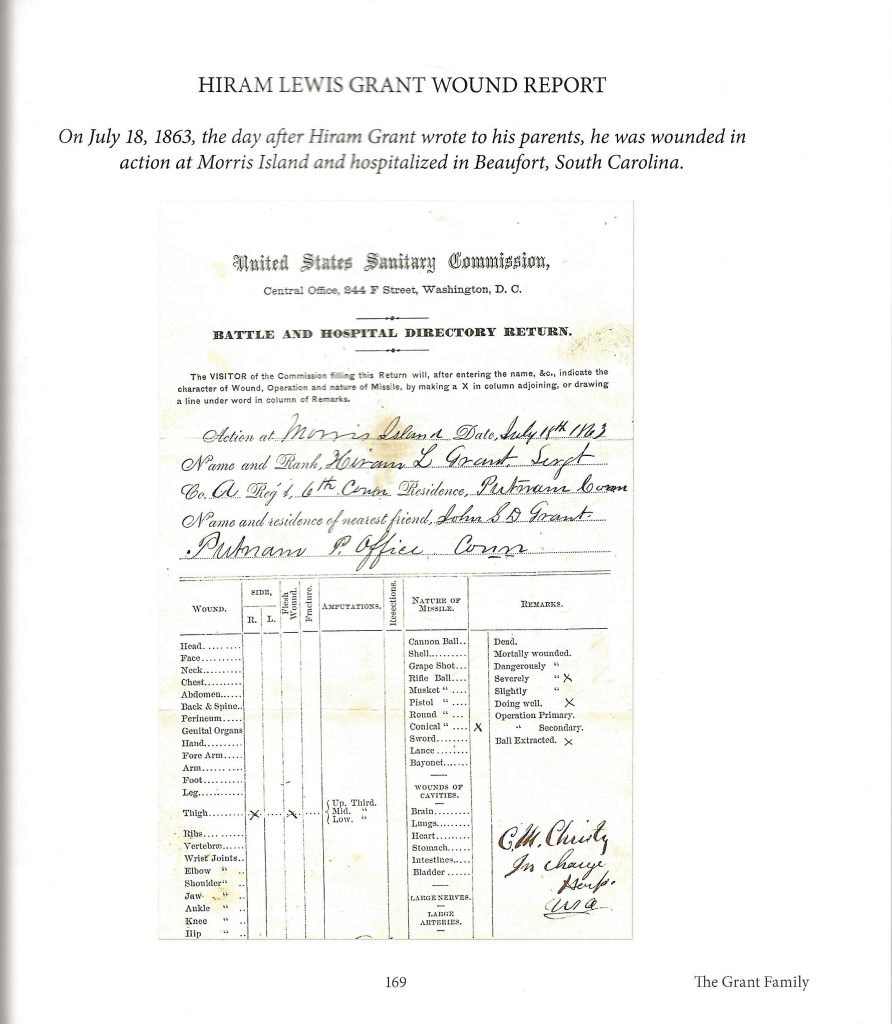
Fig. 14. Our Family Heritage, the Grant Family. Page 169
Hiram L. Grant Wound Report, Morris Is. SC, July 18, 1863
On July 18, 1863, the day after he had written the long letter to his parents, Sargent Hiram Grant of Co. A, Regiment 1 of the 6th Conn. Volunteer infantry suffered a flesh wound to the right thigh by a conical ball that was extracted. The patient was severely wounded but doing well. He was hospitalized in Beaufort, South Carolina. G. M. Christy was in charge of filing the wound report with the U.S. Sanitary Commission in Washington, D.C.
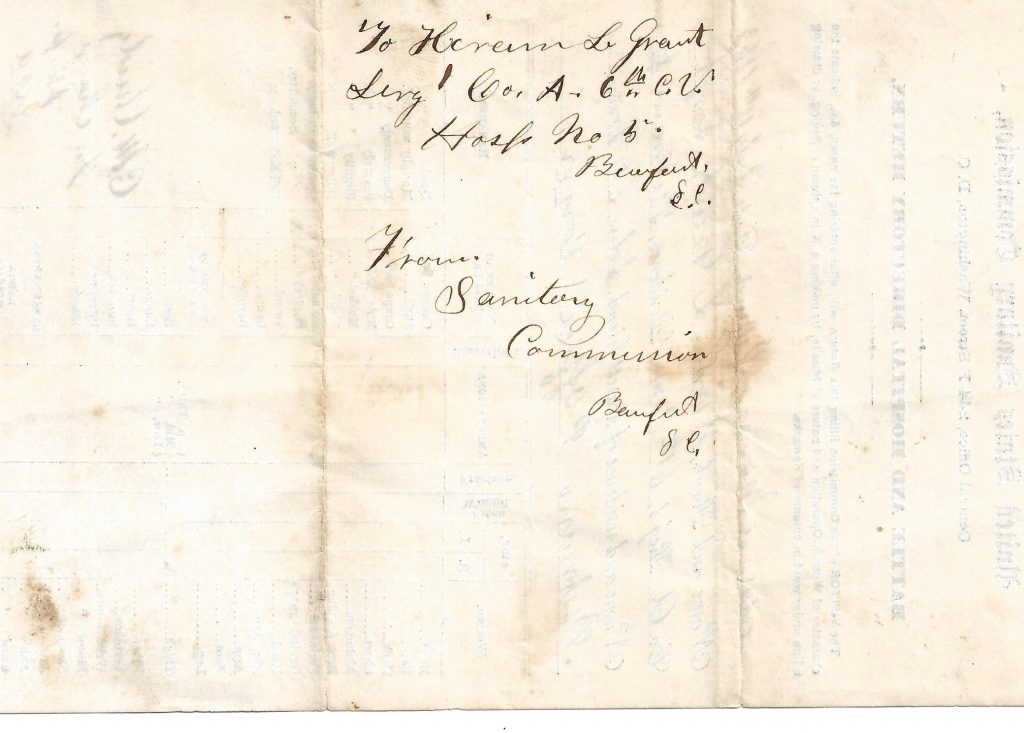
Fig. 15. Our Family Heritage, the Grant Family. Page 169
Hiram L. Grant Wound Report (back), Morris Is. SC, July 18, 1863
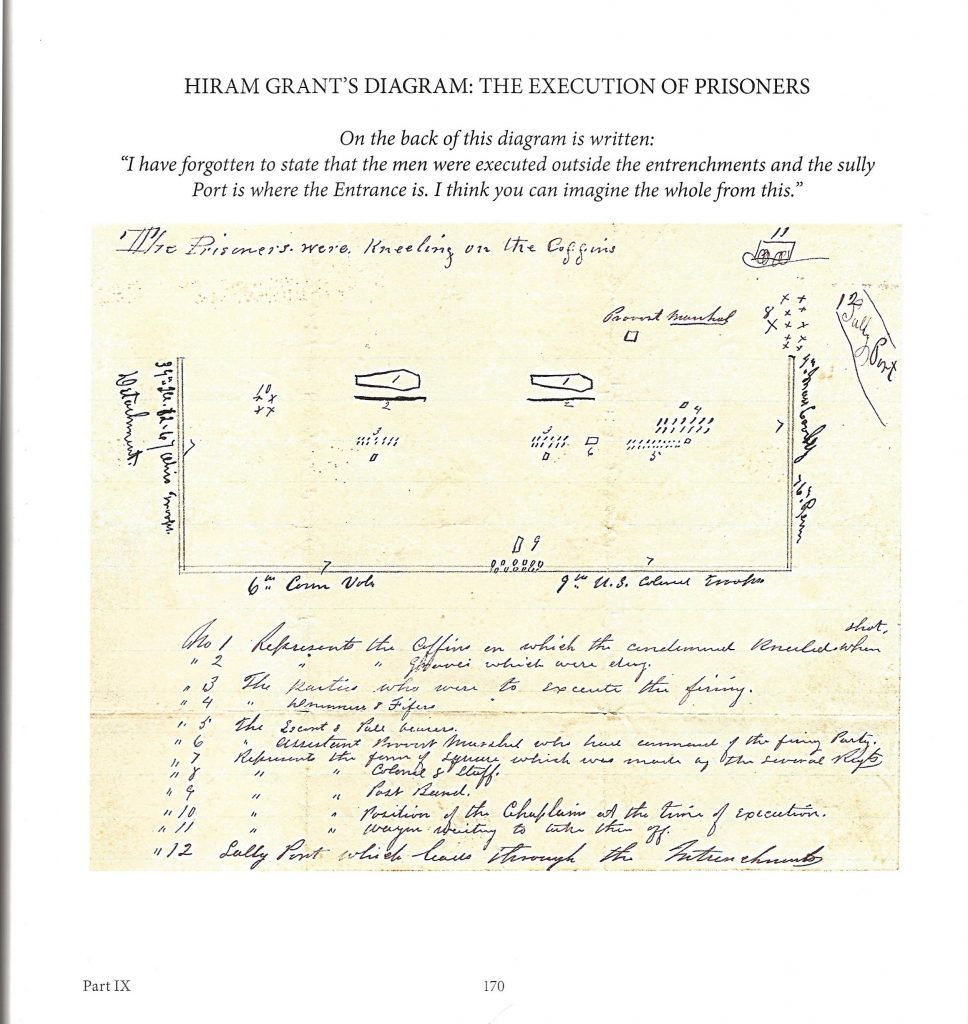
Fig. 16. Our Family Heritage, the Grant Family. Page 170
Hiram Grant’s diagram: the execution of prisoners
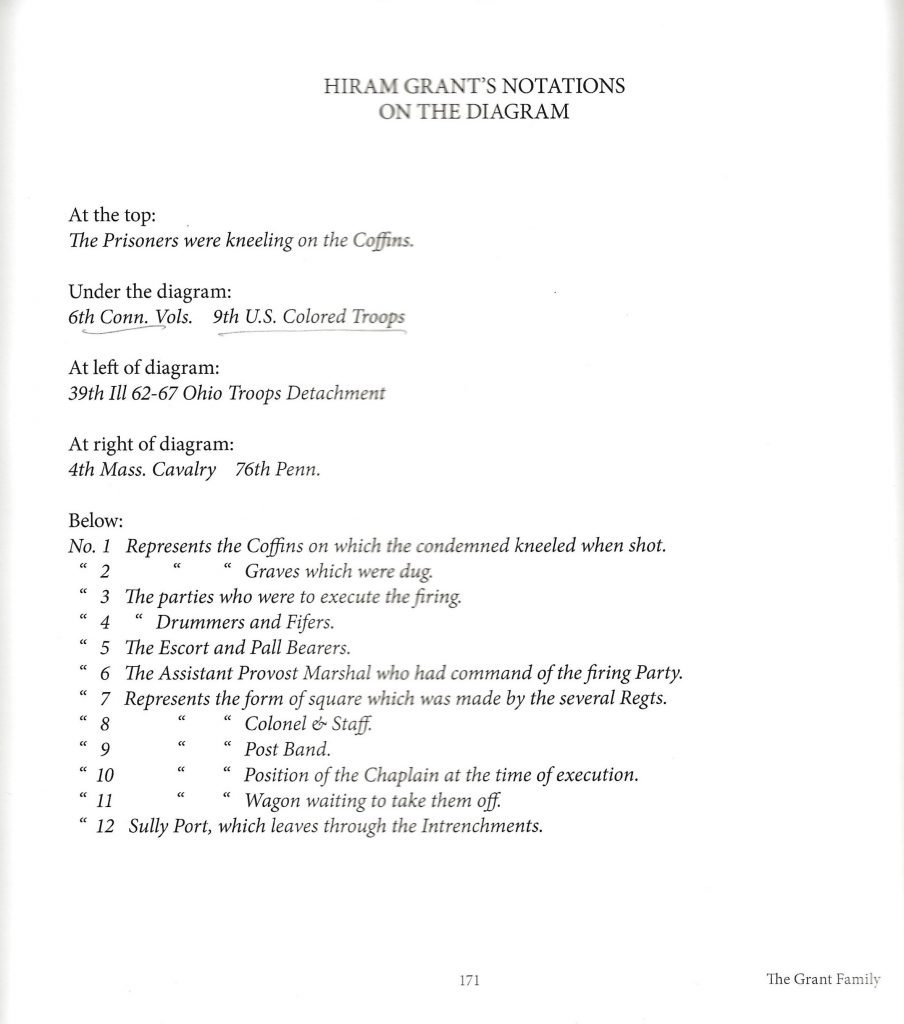
Fig. 17. Our Family Heritage, the Grant Family. Page 171
Hiram Grant’s Notation on the Diagram
Note: Figs. 12–17 are pp 167–171 reproduced from Our Family Heritage: The Hart, Hincks, Welles, Waller, Hawley, and Grant Families by Cornelia Ann Grant Nichols and used with consent.
While I await with much anticipation to read what Civil War historians might comment on Hiram’s Execution of Prisoners diagram, I am immediately drawn to the intriguing line, “9th U.S. Colored Troops.” Kurt Luther had told me on a phone call on Mar. 21, 2022 that 180,000 Colored Troops (CT) fought in the Civil War and that the Virginia Tech data base includes 200 photos of CTs. On Mar. 13, 2022, Paul Bucar told me that CTs were assigned mainly to infantry and artillery.
Also on Mar. 13, 2022, in the Photography room, I met Craig James, an African-American lawyer from North Carolina, who is a collector and seller of old photographs of black subjects: daguerreotypes, ambrotypes, tintypes, cabinet cards and cartes de visite (CDVs). He had a stand with many examples of his old framed photos, from his personal collection and for sale. Fig. 18. is the first photo I have ever seen of an African American Civil War soldier. Fig. 19 is the back cover of his book entitled, The Unfolding of Negro History through the Eye of a Lens.
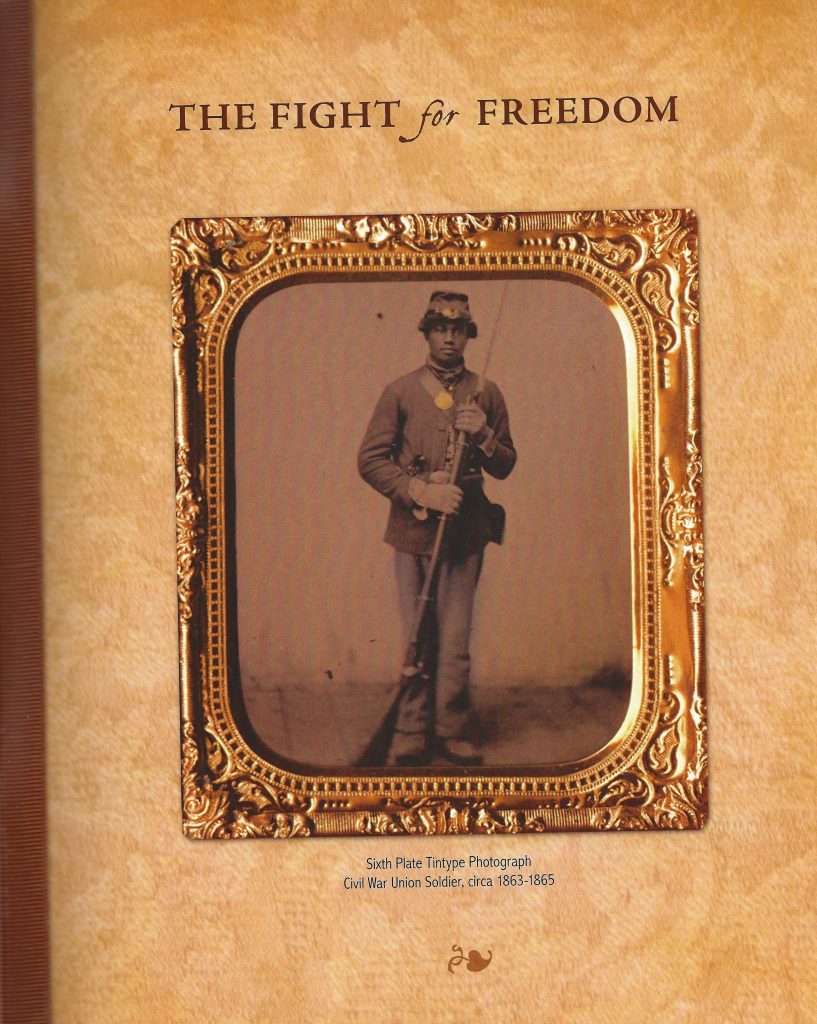
Fig. 18.
Photograph of a Civil War Union soldier from the collection of Craig James, used by permission
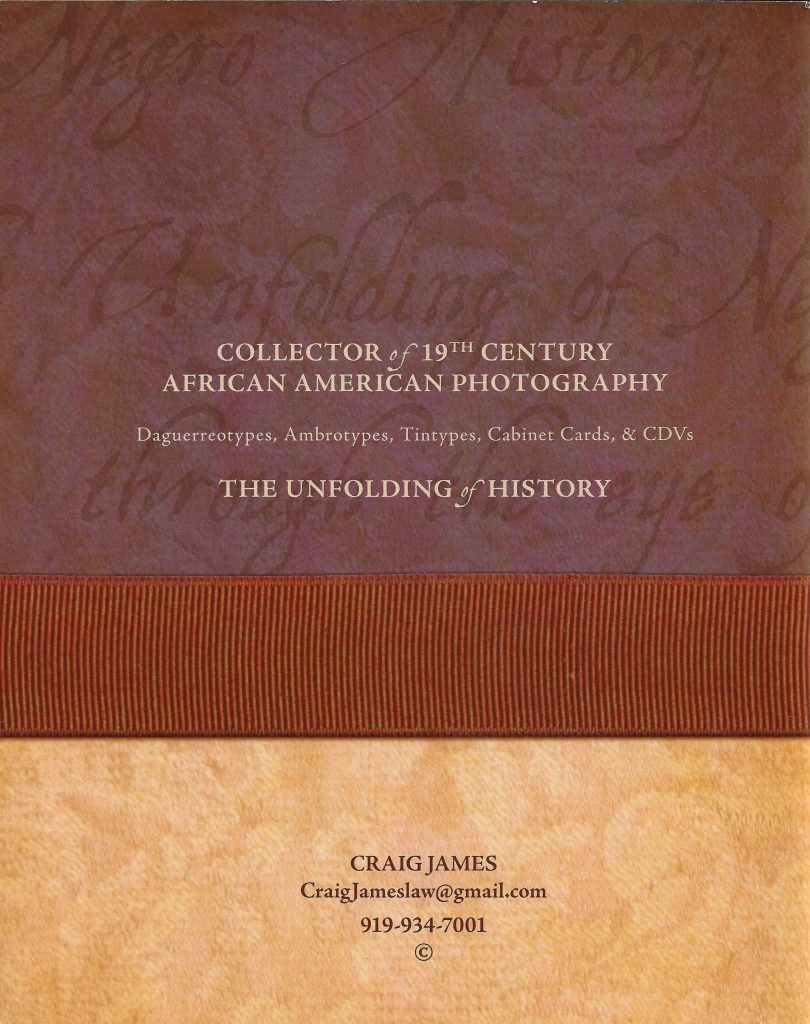
Fig. 19.
The Unfolding of Negro History through the Eye of a Lens by Craig James
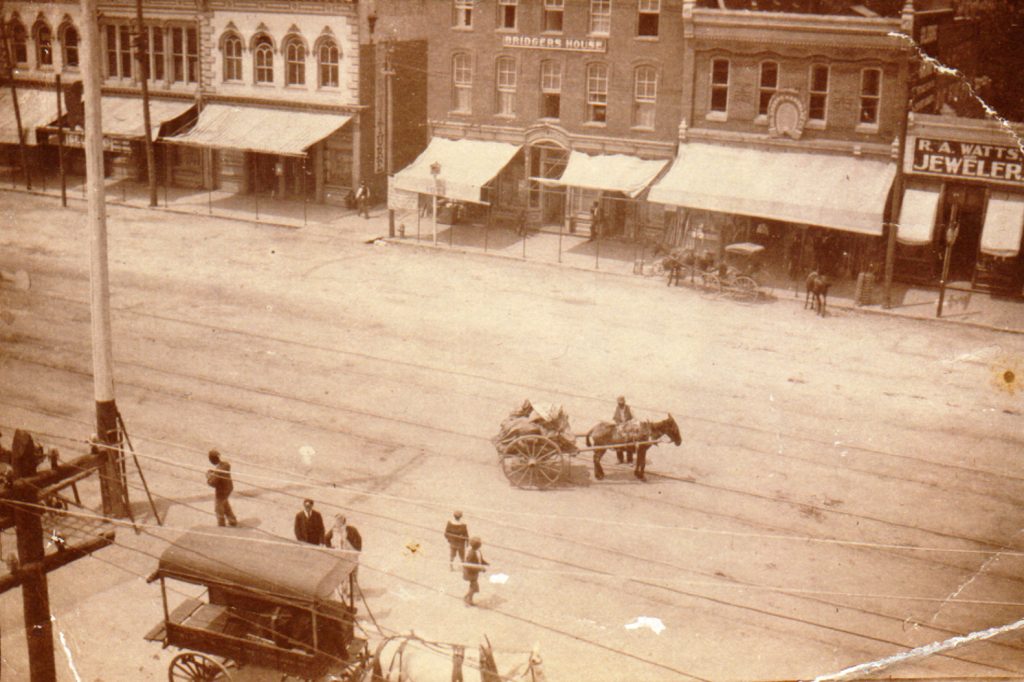
Fig. 20.
R. A. Watts Jewelry Store at the far right
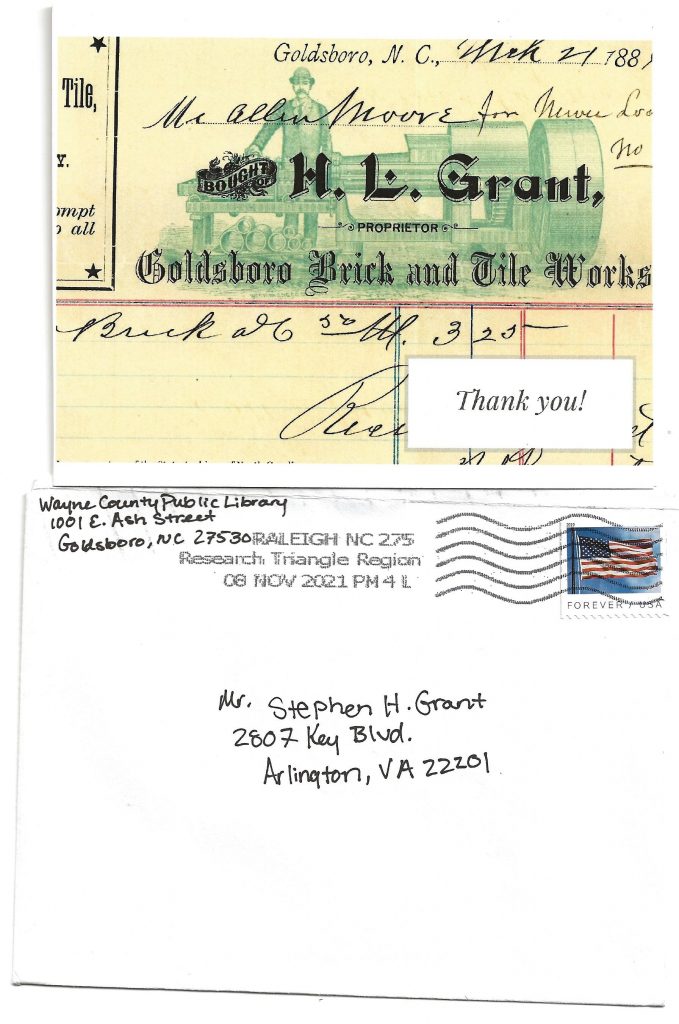
Fig. 21.
Receipt from H. L. Grant, Mar. 21, 188-, Odd Fellows Neuse Lodge #6 Papers, and envelope
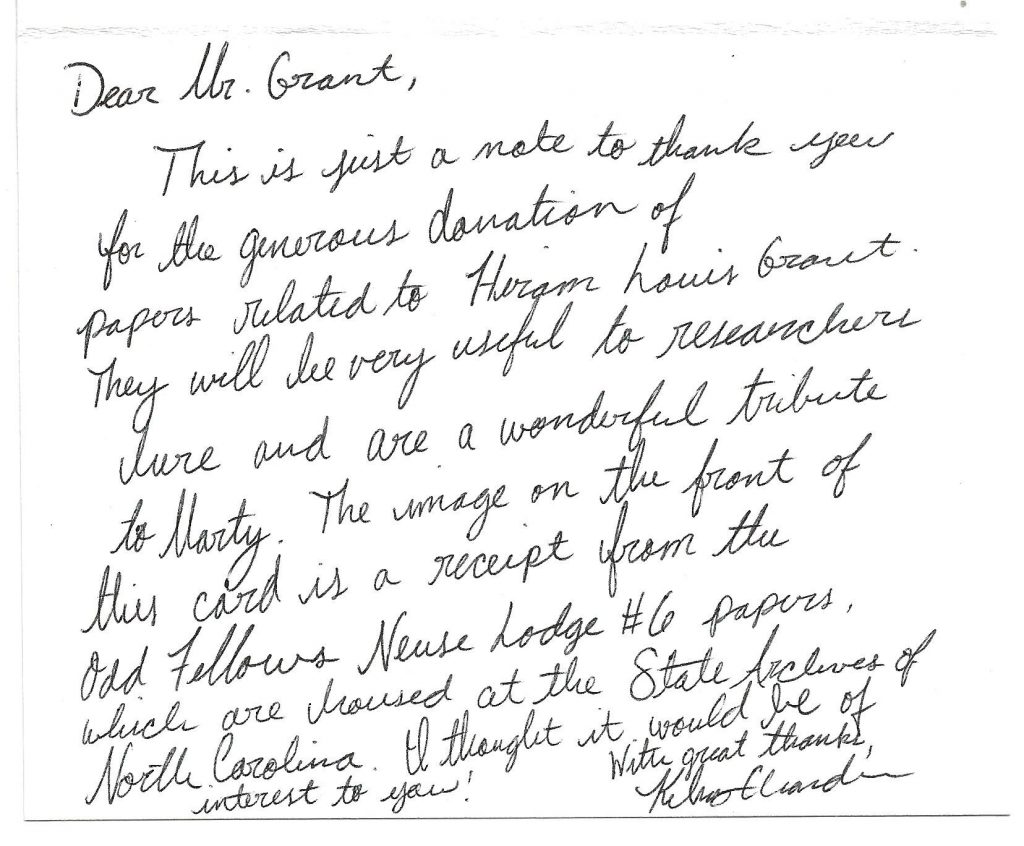
Fig. 22.
Thank-you note from Kelsey Chandler, Wayne County History Librarian, Nov. 8, 2021
I appreciated receiving a thank-you note from Kelsey Chandler on Nov. 8, 2021 for my donation of Hiram L. Grant documents. It was especially touching to see that the Wayne County Public Library had transformed a receipt from the H. L. Grant’s Goldsboro Brick and Tile Words into thank-you notepaper.
I quote from the Goldsboro Daily Argus of Mar. 8, 1922: “At the conclusion of hostilities Maj. Grant whom that event [the Civil War] found with his command in Goldsboro, decided to make this city his home, having learned to love the south, and in the summer of 1865 he opened a jewelry business here in co-partnership with the late R. A. Watts, a Virginian, an intrepid Confederate Soldier who served under Lee and who, like Maj. Grant, found himself at the surrender in Goldsboro, a prisoner of war.”
What? Grant from North and Watts from South both became prisoners at the end of the war? How did that happen? Were they included in a prisoner-of-war exchange? What does the record tell us?
A Union and a Confederate soldier met and formed a partnership to set up and run a jewelry store in Goldsboro? They did? How did that happen? Who knew? I am flabbergasted. Elusive material at this point for a short story, novel, or movie. Did any Goldsboro investigative reporters learn about the Grant/Watts gig and put pen to paper?
I learned from R. A. Watts’ obituary (he died in 1912, ten years before Hiram Grant) that as early as 1858 (when Hiram was 15) Watts had traveled through Goldsboro as a salesman. Consequently, Watts would have been the senior partner in the jewelry business.
The End or maybe the Beginning.
COMMENTS:
13 Comments
Submit a Comment
CONNECT

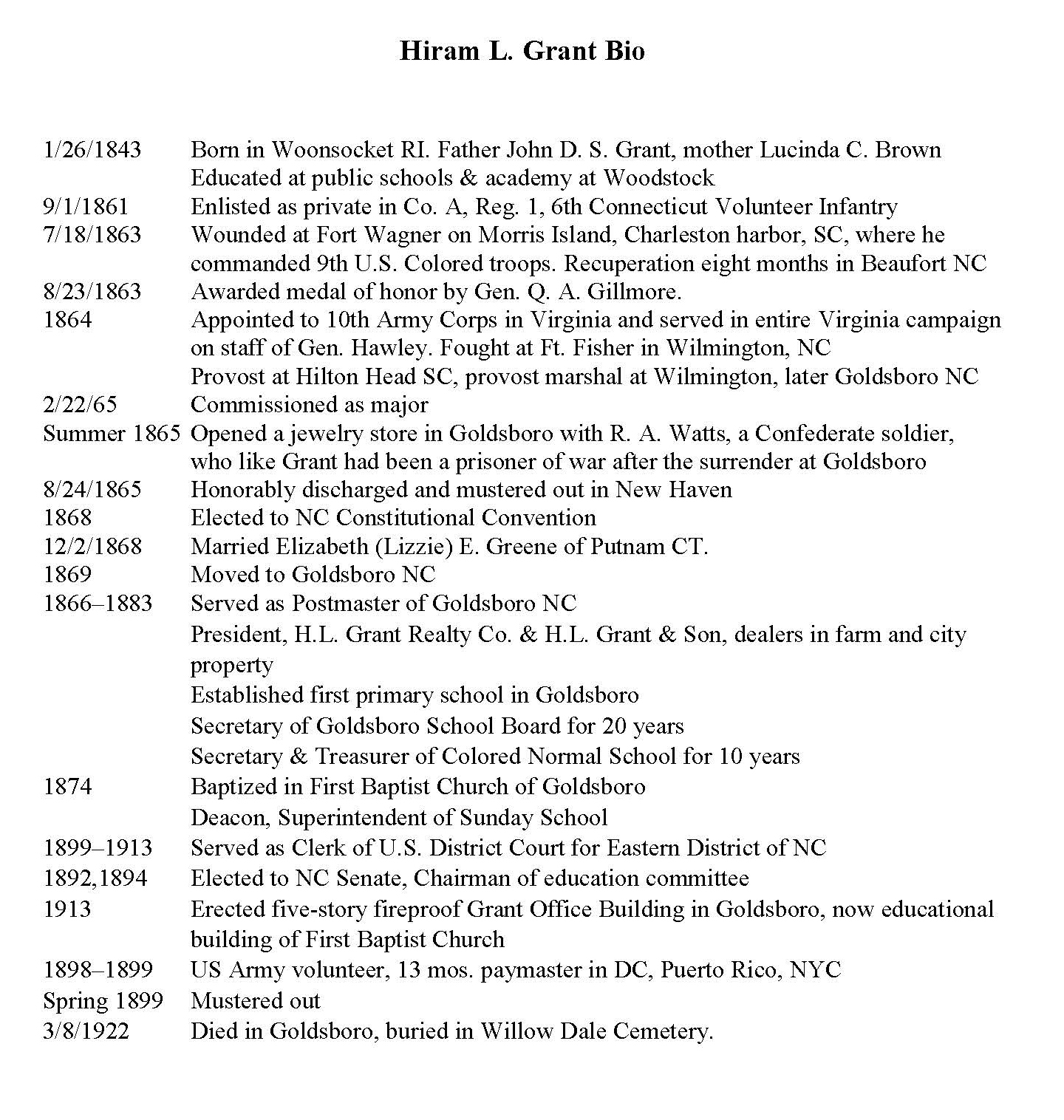
I’m particularly intrigued that an H.L. Grant seems to appear several times in the Goldsboro Star, a local African-American political newspaper edited by Colonel George T. Wassom. A “Major H.L Grant” is mentioned specifically in an article on the Wilson Convention in 1882: https://newspapers.digitalnc.org/lccn/sn91068338/1882-07-22/ed-1/seq-2/#words=Grant.
Stephen, what an amazing story. The manner in which you have woven facts and artifacts together is extraordinary. Your work will, no doubt, inspire others to embark upon their own personal journey to chronicle their family history. I enjoyed every word. I also appreciate the reference and inclusion on my book and image. Thank you for a wonderful piece of history. Great job!!
Thanks for this beautiful presentation. Your diligent genealogical and historical research produced beautiful results. I greatly enjoyed it, especially the video with you and Kurt Luther. You gave a concise and enthusiastic summary of your impressive work. Congratulations!
As an old schoolmate of Steve, I thoroughly enjoyed all this history. The several boxes of my family history that my brother had assembled many years ago that has both civil and Rev. war family material in it is now on my agenda to finally pay some attention to it. Thanks to Steve, a gentleman and a scholar!
I am lucky that my mother’s family had a lot of pictures of my grandmother’s generation, and we have one unlabeled formal picture that looks so much like her only brother I know it must be my great-grandfather. Nothing as good as your post-Peace Corp hippie haircut and shirt, though.
Read the whole post. Outstanding!
Dear Cousin Steve: This is a wonderful presentation that makes viewers want to follow every detail and marvel at your tenacity!
Funny to see you Steve and Yonel in that photo ! So I guess I had met your dad when he came with his wife at the bowling of the Hotel Ivoire to see Yonel and his little friend play 🙂
Thank you Stephen. A very thorough and comprehensive account. Certainly is a nice example of what a dedicated descendant can uncover! Congratulations!
I’m delighted to see that you donated those four items to the Wayne County Public Library in Goldsboro, as so many families have archival material that might be of great benefit to historians, genealogists, and other researchers, and I always encourage people who tell me about their family papers that they ought to consider allowing local or regional manuscript repositories or libraries to scan their papers even if they want to keep the originals (which makes perfectly good sense to me!), to add to what we know and what stories we can tell about the past.
This is so incredibly interesting to read and to know about. Thank you so much for forwarding it to me. It is absolutely fascinating, as well as extremely well written! I hope you will continue to research the family and to inform everyone through your blog.
What a fascinating piece. I particularly enjoyed reading about how your detective work uncovered the larger story. And the family pictures are priceless. You’ve inspired me to do more research on the Civil War soldiers from our house. Thanks so much for sharing it.
I, too, am descended from Hiram Louis Grant. His daughter, Mabel Grant Bowles, was my great-grandmother. She married John Franklin Bowles of Iredell County, NC. They had four children, one of whom was Louis Grant Bowles, my maternal grandfather.